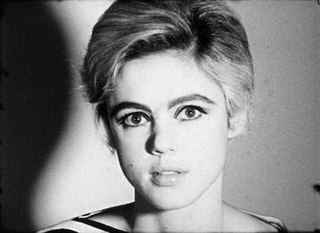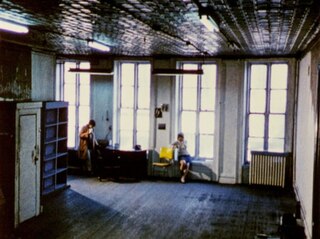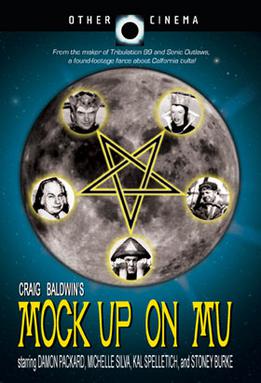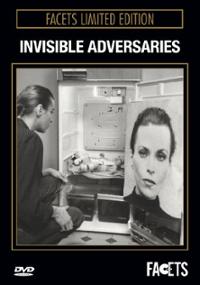Serene Velocity is a 1970 American experimental short film directed by Ernie Gehr. Gehr filmed it in the basement hallway of a Binghamton University academic building, using a static camera position and changing only the focal length of the camera. It is recognized as a key work of structural filmmaking and has been inducted into the U.S. National Film Registry.
Structural film was an avant-garde experimental film movement prominent in the United States in the 1960s. A related movement developed in the United Kingdom in the 1970s.

The Screen Tests are a series of short, silent, black-and-white film portraits by Andy Warhol, made between 1964 and 1966, generally showing their subjects from the neck up against plain backdrops. The Screen Tests, of which 472 survive, depict a wide range of figures, many of them part of the mid-1960s downtown New York cultural scene. Under Warhol's direction, subjects of the Screen Tests attempted to sit motionless for around three minutes while being filmed, with the resulting movies projected in slow motion. The films represent a new kind of portraiture—a slowly moving, nearly still image of a person. Warhol's Screen Tests connect on one hand with the artist's other work in film, which emphasized stillness and duration (for example, Sleep and Empire, and on the other hand with his focus after the mid-1960s on documenting his celebrity milieu in paintings and other works.

Wavelength is a 1967 experimental film by Canadian artist Michael Snow. Considered a landmark of avant-garde cinema, it was filmed over one week in December 1966 and edited in 1967, and is an example of what film theorist P. Adams Sitney describes as "structural film", calling Snow "the dean of structural filmmakers."

Ernie Gehr is an American experimental filmmaker closely associated with the Structural film movement of the 1970s. A self-taught artist, Gehr was inspired to begin making films in the 1960s after chancing upon a screening of a Stan Brakhage film. Gehr's film Serene Velocity (1970) has been selected for preservation in the United States National Film Registry. Gehr served as faculty at the San Francisco Art Institute.

The Fairmont San Francisco is a luxury hotel at 950 Mason Street, atop Nob Hill in San Francisco, California. The hotel was named after mining magnate and U.S. Senator James Graham Fair (1831–94), by his daughters, Theresa Fair Oelrichs and Virginia Fair Vanderbilt, who built the hotel in his honor. The hotel was the vanguard of the Fairmont Hotels and Resorts chain. The group is now owned by Fairmont Raffles Hotels International, but all the original Fairmont hotels still keep their names.

Nathaniel Dorsky is an American experimental filmmaker and film editor. His film career began during the New American Cinema movement of the 1960s, when he met his partner Jerome Hiler. He won an Emmy Award in 1967 for his work on the film Gaugin in Tahiti: Search for Paradise.
Cosmic Ray is a 1962 American experimental short film directed by Bruce Conner. With both found footage and original material, it features images of countdown leader, a nude woman dancing, a Mickey Mouse cartoon, and military exercises. It is soundtracked by a performance of Ray Charles's "What'd I Say" and has been recognized by some critics as one of the first music videos.

Mock Up on Mu is a 2008 science fiction collage film directed by American experimental filmmaker Craig Baldwin. The film is a fictionalized continuation of the stories of L. Ron Hubbard, Jack Parsons, and Marjorie Cameron. Baldwin assembled it mostly from found footage but began introducing more original live-action footage than in earlier projects.

Invisible Adversaries is a 1977 Austrian experimental drama film directed by Valie Export, her debut feature film.
The 51st New York Film Festival was held September 27 – October 13, 2013.
Tribulation 99: Alien Anomalies Under America is a 1991 science fiction collage film directed by Craig Baldwin. The film presents a chronicle of U.S. involvement in Latin America through a pseudo-documentary about an alien invasion.
Walden, originally titled Diaries, Notes and Sketches , is a 1968 American film by experimental filmmaker Jonas Mekas. After several years of filming everyday scenes from his life, Mekas was commissioned by the Albright–Knox Art Gallery to make Walden. It was his first major diary film, and he named it after Henry David Thoreau's 1854 memoir Walden. Mekas's film has received acclaim as a work of avant-garde cinema.
Andrew Noren was an American avant-garde filmmaker.

Jerome Hiler is an American experimental filmmaker, painter, and stained glass artist. Having started in New York during the New American Cinema movement, Hiler and his partner Nathaniel Dorsky moved in 1971 to San Francisco, where for many years his work was shown in the context of private salon screenings. He began to publicly screen his films in the late 1990s, releasing new films regularly since 2010. Hiler's work makes use of vivid colors, musical rhythms or structures, and layered superimpositions edited in camera.
All My Life is a 1966 American experimental short film directed by Bruce Baillie. It shows a continuous shot of a fence, soundtracked by Ella Fitzgerald's 1936 debut single "All My Life". Film critic P. Adams Sitney identified it as an early example of what he termed structural film.
Variations is a 1998 American short silent avant-garde film directed by Nathaniel Dorsky. It is the second film in a set of "Four Cinematic Songs", which also includes Triste, Arbor Vitae, and Love's Refrain.
Triste is a 1996 American avant-garde short film directed by Nathaniel Dorsky. It is the first in a set of "Four Cinematic Songs", which also includes Variations, Arbor Vitae, and Love's Refrain.
Alaya is a 1987 American avant-garde short film directed by Nathaniel Dorsky. It shows sand filmed in different ways.
17 Reasons Why is a 1987 American avant-garde short film directed by Nathaniel Dorsky. Working with a collection of secondhand portable cameras, Dorsky used the unslit 8 mm footage to create a split screen with four quadrants. Normally screened on 16 mm film at 16 frames per second, it is one of his only works to have been shown as a digital transfer.









